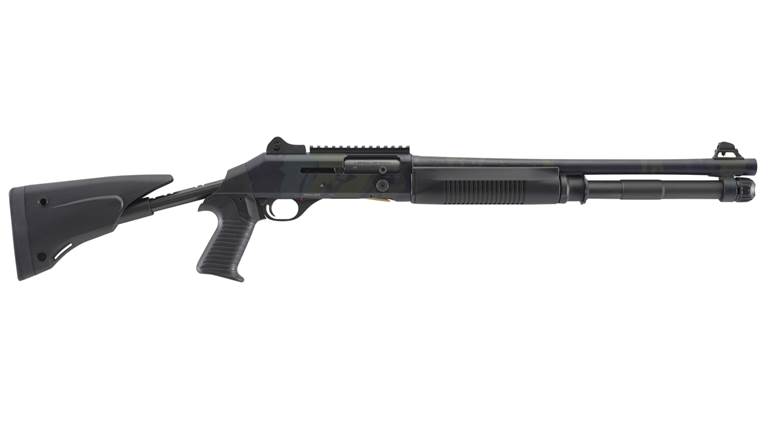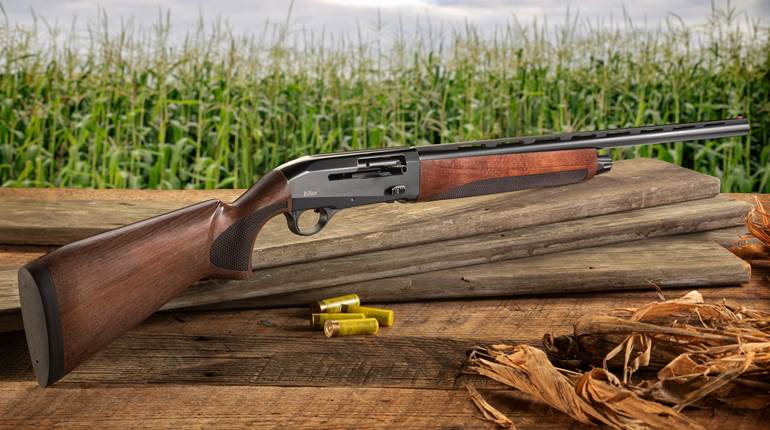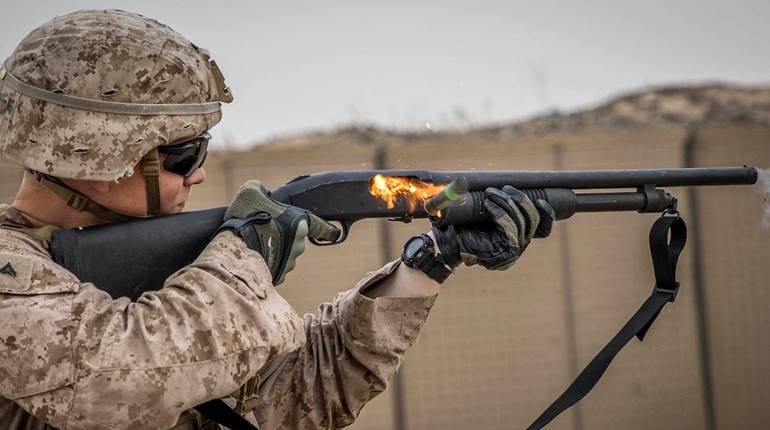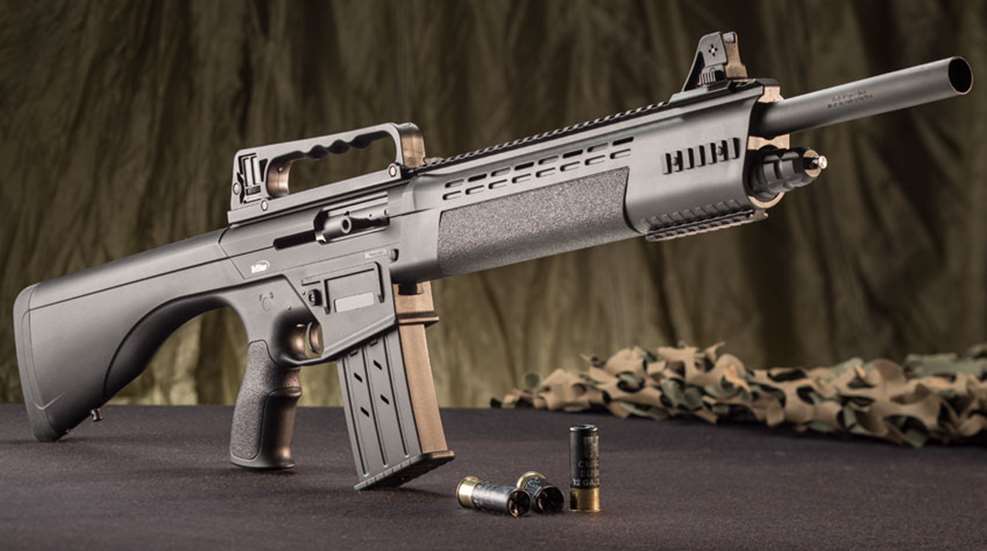
That a shotgun is a capable, if not perfect, firearm for protecting one’s person, family, abode or homestead is undeniable. But, as opinions vary greatly, there’s little consensus as to what constitutes an ideal home-defense scattergun. Semi-automatic rifle owners who desire their shotgun to appear and function (somewhat) like their rifle, as well as individuals preferring detachable box magazines to tubular ones or who cherish rail space for adding “extras,” need to pay attention to the subject of this review, the Turkish-made TriStar KRX Tactical.
Outwardly, the TriStar KRX Tactical reflects its moniker; there’s certainly some resemblance to the AR-15 and other arms of that ilk. Too, the KRX Tactical employs a two-piece receiver. By necessity, the upper unit is CNC-machined from metal—in this case, lightweight aluminum. By contrast, the lower unit, which incorporates the buttstock, pistol grip and magazine well, is molded from polymer. The KRX Tactical is fed from a detachable box magazine, not a traditional, tubular magazine. The steel, single-stack magazines hold five rounds of either 2¾" or 3" 12 gauge, and two ship with the gun.
Reminiscent of many AR-platform rifles, the KRX Tactical’s non-adjustable buttstock is nearly straight; there’s minimal drop from comb to heel. Owners of ARs with A2 stocks will feel right at home. Moreover, the bottom features an arch extending from the rear of the pistol grip to just forward of the sling swivel stud. Beyond aesthetics, the design slightly reduces heft and bulkiness. Capping the butt is a pliable, 1"-thick rubber recoil pad that, during testing, proved its merit when firing 3" magnum shells.

The pistol grip has molded-in texturing on the side panels that wrap around to the frontstrap. Alone, the texturing isn’t likely to improve purchase too much; however, when coupled with the grip’s palm swell, strategic finger grooves and flared bottom, a secure grip is assured. Moving forward, the trigger guard isn’t sized for thick, wintertime gloves, but the magazine well is flared slightly to hasten magazine changes.
Right-handed owners of ARs will find comfort in the location and operation of the non-bilateral fire controls. Located on the lower unit are the trigger, two-position safety, bolt catch and magazine-release button. The single-stage trigger broke at 6 lbs., 6 ozs., after slight, albeit smooth, creep. There was noticeable overtravel, though, and the trigger reset distance was quite long too, ending with an audible “click.” Still, its characteristics were better than those of many shotgun triggers. Two other controls, described by TriStar as the “cartridge ramp lock button” and “fixing nut barrel,” are on the right and bottom front, respectively, and are necessary for takedown.
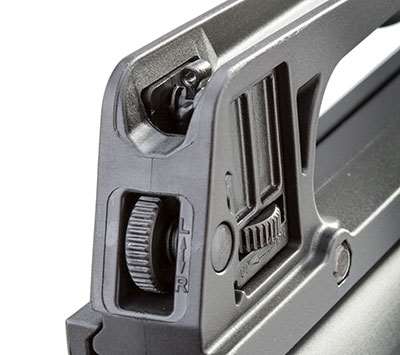
The one-piece, polymer fore-end, which surrounds the barrel and link tube (it resembles a tubular magazine but doesn’t serve as such), is chock full of lines and angles that enhance the KRX’s appearance. When compared to the texturing of the pistol grip, that on the forearm is considerably more aggressive and purchase-enhancing. On the top of the gun is 21 1/2" of Picatinny rail, and at the 6-o’clock position there’s 3¾" more. Ridges resembling rail segments are located at the fore-end’s 3- and 9-o’clock positions, however, these are purely ornamental. Vents on the top at each side allow excess gases to escape.
Topping the KRX Tactical’s rails are removable open sights. Contained within the polymer carry handle, the rear sight has four sighting options, including: a peep, an aperture, a V-notch and a post. A wheel on the rear of the carry handle enables windage adjustments, while another on the right side adjusts elevation. Like the rear sight, the synthetic front has four sighting options, including: a fiber-optic pipe, a post, a V-notch and an aperture.
The 20" barrel is threaded to accept Beretta/Benelli Mobilchoke tubes. Shipped with the test gun was one featuring two rows of in-line ports circumscribing the tube, while the other had two rows of staggered, enlarged ports and “standoff” teeth typically seen on guns used for tactical door entry. Both tubes had an internal diameter of 0.729" (i.e. cylinder bore).
Removing the aluminum link tube cap (or fore-end retainer) reveals the heart of the KRX Tactical. As with most Turkish-made shotguns, it features gas operation. When fired, gas bled from two barrel ports impinge upon a piston that pushes the action bar and sleeve rearward. This movement, in turn, permits the bolt—resting atop the dual action bars—to unlock. Subsequently, during the bolt’s rearward travel the hull is extracted and ejected, the hammer is cocked and then, thanks to forward momentum provided by the recoil spring surrounding the “magazine tube”/link tube, a shell is fed from the magazine into the chamber and lockup is completed. Because the piston is self-adjusting, 2¾" and 3" 12-ga. shells can be used interchangeably.
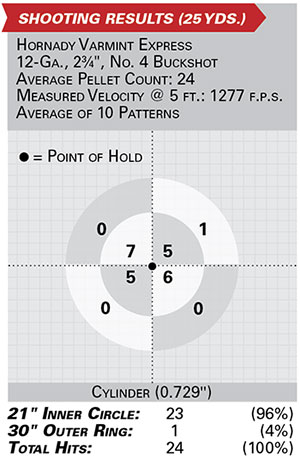 Unimpressed by the polymer sights, we opted to top the KRX Tactical with a Leupold LCO for testing. To remain true to the gun’s intended purpose, we selected a proper self-defense load—Hornady Varmint Express 2¾" No. 4 Buckshot—for patterning from a sandbag at 25 yds. using the non-breaching choke tube. The results are tabulated nearby. Overall, the TriStar KRX Tactical delivered evenly distributed patterns, with 96 percent of the pellets staying within the target’s 21" inner circle. For the majority of personal-protection scenarios—especially in and around the home—this combination would excel.
Unimpressed by the polymer sights, we opted to top the KRX Tactical with a Leupold LCO for testing. To remain true to the gun’s intended purpose, we selected a proper self-defense load—Hornady Varmint Express 2¾" No. 4 Buckshot—for patterning from a sandbag at 25 yds. using the non-breaching choke tube. The results are tabulated nearby. Overall, the TriStar KRX Tactical delivered evenly distributed patterns, with 96 percent of the pellets staying within the target’s 21" inner circle. For the majority of personal-protection scenarios—especially in and around the home—this combination would excel.
But that wasn’t enough testing for us, so we then fed the KRX Tactical a challenging diet of factory and hand-loaded 2¾" and 3" 12-ga. leftovers that included target, light and heavy field, waterfowl (steel), buckshot, and slug loads. A gas-operated shotgun with a self-regulating piston should function flawlessly regardless of the load, and the TriStar did. Outside of a few subsonic shells, which we didn’t expect to cycle the action, everything else cycled without issue. Also, thanks to gas operation and the pliable recoil pad, perceived recoil was relatively mild even with magnum loads. Operationally, our only complaint was the fact that the magazine didn’t drop free when the magazine release button was pressed; we had to manually pull it out. Otherwise, we were pleased.
Given its $595 suggested retail price, and despite its “cheap” sights and visible tooling marks on the action bar, the TriStar KRX Tactical is dependable with nigh every load and, as proven in testing, delivers the goods. What more could you ask from a defensive arm?














